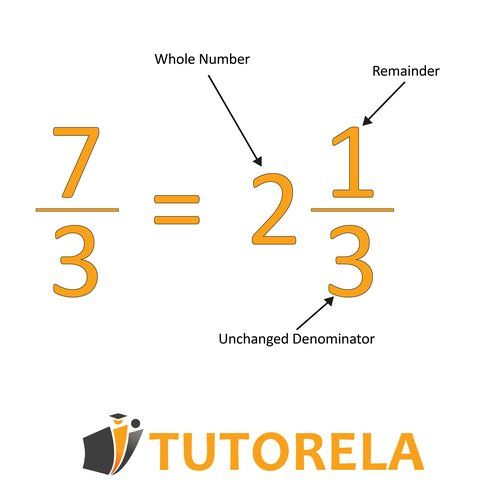Fraction representing a whole number or greater than a whole.
Improper Fractions
Improper Fractions
What is an improper fraction?
How do you convert an improper fraction to a mixed number?
We ask – how many times does the denominator go into the numerator?
This will be our whole number. What remains will be the numerator in the fraction that is in the mixed number.
How do you convert a mixed number to an improper fraction?
We multiply the number of wholes by the denominator.
To the result we obtained, we add the numerator – the final result will be the new numerator.
In the denominator – we won't change anything.

Improper Fractions
What is an improper fraction?
An improper fraction is a fraction that represents a whole number or a number greater than a whole.
It is written with only a numerator and a denominator, but it is not a simple fraction and will always represent a number that is greater than a whole or a whole number, not just a part of a whole.
How can you remember this?
The word "improper" suggests that this fraction is not really a simple fraction, not really a part of a whole, but a slightly different fraction.
How do you identify an improper fraction?
In an improper fraction, the numerator will always be greater than or equal to the denominator.
In any case, the numerator will never be less than the denominator.
Let's practice a bit:
Is this fraction an improper fraction?
The answer is yes!
The numerator is greater than the denominator, which means the fraction represents a number greater than one – an improper fraction!
Another exercise:
Is this fraction an improper fraction?
Absolutely not. In this fraction, the numerator is smaller than the denominator, which means it represents a number less than one and therefore is not an improper fraction.
Another exercise:
Is this fraction an improper fraction?
The answer is yes! In this fraction, the numerator and the denominator are the same. This means it represents a whole.
How do you convert an improper fraction to a mixed number?
Reminder: A mixed number is a number that consists of both a whole number and a fraction.
If we have an improper fraction with a numerator larger than the denominator, we can convert it to a mixed number.
We ask – how many times does the denominator go into the numerator.
This will be our whole number. What remains will be the numerator in the fraction that is part of the mixed number.
To understand this better, let's see it through an example:
Convert the improper fraction to a mixed number.
Solution:
We ask how many times goes into ? The answer is times. This will be our whole number.
We will have left, so we get:
How do you convert a mixed number to an improper fraction?
We multiply the whole number by the denominator.
To the result we add the numerator – the final result will be the new numerator.
In the denominator – we don't change anything.
Let's see this with an example:
Convert the mixed number to an improper fraction.
Solution:
Multiply the whole number by the denominator to get .
Add the numerator to to get .
We get:
How do you convert a whole number to an improper fraction?
If we have an integer, for example , we can easily convert it into an improper fraction.
All we need is for the denominator to fit into the numerator exactly as the number of integers. And in our example .
For example:
How do you convert an improper fraction to a whole number?
An improper fraction can be converted to a whole number only if the numerator is equal to the denominator, in which case the numerator will be or
if the numerator is divisible by the denominator without a remainder.
Comparison of improper fractions
To know which improper fraction is larger, we recommend one of the following 2 options:
- Bring both fractions to a common denominator and check which one has the larger numerator.
When they have the same denominators, the fraction with the larger numerator will be the larger fraction. - Convert to mixed fractions and determine which one has a larger whole number. If one of them clearly has a larger whole number, it will be the larger fraction. If the whole numbers are the same, bring the remaining fraction to a common denominator with the other remaining fraction and check according to method 1.








